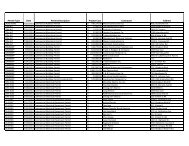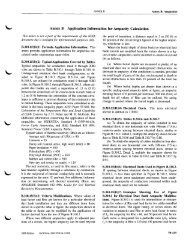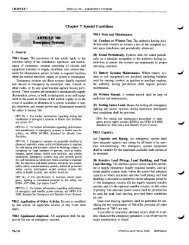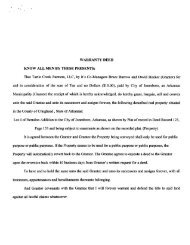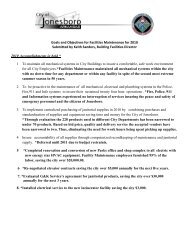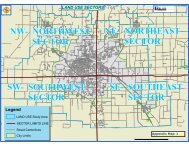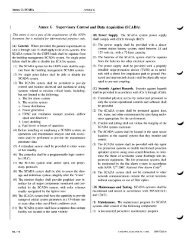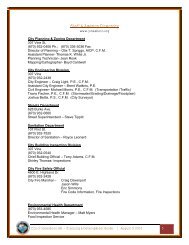Opposition material - City Clerk - City of Jonesboro
Opposition material - City Clerk - City of Jonesboro
Opposition material - City Clerk - City of Jonesboro
Create successful ePaper yourself
Turn your PDF publications into a flip-book with our unique Google optimized e-Paper software.
Effects <strong>of</strong>Prohibition 3<br />
This study takes a two-stage approach to examine the influence <strong>of</strong>countylevel<br />
policies concerning the sale <strong>of</strong> alcohol in Arkansas. First, we replicate<br />
and extend a study used to support the prohibition <strong>of</strong>the sale <strong>of</strong>alcohol based<br />
on arrest rates. Second, we replicate studies carried out in Kentucky and<br />
Tennessee to consider whether alcohol-prohibition policies have an effect on<br />
alcohol and drug related automobile crashes, an outcome measure that better<br />
reflects behavior. In both sections we use analysis <strong>of</strong> variance (ANOVA) to<br />
consider the effect <strong>of</strong> policy alone and multivariate ordinary least squares<br />
(OLS) regression analysis to test a more fully specified model before drawing<br />
conclusions. We conclude by discussing policy options in light <strong>of</strong>the findings.<br />
Alcohol Policy in Arkansas<br />
In a study <strong>of</strong> great policy salience for Arkansans, Grossman (1997)<br />
examines adult and adolescent drug and alcohol arrests in Arkansas by<br />
comparing 43 dry with 32 wet counties in the state. He reports that between<br />
1992 and 1996 an average <strong>of</strong> 12.5 arrests for drunk driving per 1,000 people<br />
in wet counties took place compared to the rate <strong>of</strong>8.7 arrests per 1,000 in dry<br />
counties. Grossman also finds an average <strong>of</strong> 32 arrests per 1,000 for adult<br />
alcohol and drug related crimes in wet counties, compared to the rate <strong>of</strong> 21<br />
arrests per 1,000 in dry counties. He concludes that alcohol acts as a<br />
"gateway" substance, leading to the use <strong>of</strong>other drugs, since there were 2.5<br />
drug-related arrests per 1,000 juveniles in wet counties as compared to 1.7<br />
arrests per I,000 in dry counties. Overall, Grossman concludes that the ready<br />
availability <strong>of</strong>alcohol is a key factor in alcohol- and drug-related crimes.<br />
The importance <strong>of</strong>Grossman's research in determining county-level public<br />
policy in the state <strong>of</strong> Arkansas is indisputable. Specifically, proponents <strong>of</strong><br />
alcohol control policy have made frequent and prominent use <strong>of</strong>his findings,<br />
pointing to his analysis to buttress morality-based arguments. For instance,<br />
prohibitionists state that having a wet county could lead to "a decline in morality,<br />
increased drunk driving and a decrease in family values" (Hinkle 1999) and<br />
could lead to higher rates <strong>of</strong>alcohol addiction (Heard I999a). These argwnents<br />
are premised on Grossman's (1997) assertion that alcohol is a "gateway" to<br />
drug use which "establish(es) the condition for illegal drug use" (I) and that<br />
limiting access to alcohol will prevent their use. However, recent research<br />
suggests that drug and alcohol addiction is at least partially genetically<br />
predisposed (Sutka 2000).<br />
Multiple critiques may be applied to his methodology and corrections,<br />
suggesting the need for a more rigorous analysis. First, Grossman's distinction



